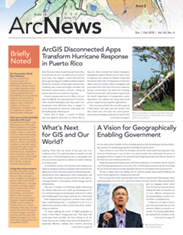Engineering Firm Applies ArcGIS to Accelerate Site Surveys and Planning
When telecommunications companies roll out new fiber communication networks, the success and long-term profitability of these ventures hinge in large part on the quality of data collected at the very outset. If the data is incomplete or out-of-date—it misses a new road or doesn’t identify a piece of land as private, for example—unforeseen issues can emerge that increase costs during the building phase and may even impede the network’s efficient operation for years to come.
The traditional approach to collecting the data that informs fiber network installation used to be highly manual. Surveyors brought printed maps, notepads, laptops, and cameras with them to conduct surveys in the field, which took about three days to complete. The surveyors would then spend approximately two days in the office transferring their findings to spreadsheets.
Engineering solutions company 4site, based in Limerick, Ireland, identified an opportunity to streamline this survey process not only to improve the accuracy of the data collected but also to shorten the time required to share it.
A Completely Paperless Process
After evaluating a number of possible GIS solutions for this, 4site selected the ArcGIS platform, including Collector for ArcGIS, as the foundation for creating a customized survey and app.
“The real power of ArcGIS is that you can adapt it,” said Niall Looney, the operations director at 4site. “We were able to use products from the ArcGIS platform to develop a GIS-led survey workflow called 4Survey that we believe is the first of its kind in the fiber deployment industry.”
Now, 4site’s mobile teams use Collector for ArcGIS on smartphones and iPads to view, query, and gather data in the field pertaining to existing and planned fiber networks. Dubbed the 4Survey app, this allows them to complete audits guided by preset drop-down boxes, verify existing network features, take and upload images, validate network maps, and add new data points with attributes.

All the information collected in the field with this mobile app is then transferred digitally back to 4site’s planners in the company’s Fibre Centre of Excellence, located at its headquarters, in what is a completely paperless process. The planners can see survey data in ArcGIS Online as soon as it becomes available and start designing new networks instantly using ArcGIS Pro.
In the first six months following its introduction, 4Survey was used to provide survey, design, and planning services for the rollout of fiber to more than 100,000 homes and businesses in Ireland and the United Kingdom.
Delivering Fiber More Quickly and Cost Effectively
Using its ArcGIS technology-based survey app and workflow, 4site can now complete fiber network surveys for its clients in half the time it used to take.
The new workflow means that field-based surveyors are significantly more productive when they are out on a job, as they can perform all their required tasks using just one device. They also no longer have to return to the office to type up reports or manually link images to audits.
In addition, 4site’s planners now receive complete, accurate survey data directly to their desktops. So as soon as the data is collected, they can carry out the planning and design phase for new fiber installations. It’s a much quicker process than it used to be.
“4site has reduced its turnaround time for designing new fiber networks by around 25 percent,” estimated Looney. “This means that we can help our clients to reduce their time to market and help them deliver next generation fiber networks to homes and businesses more quickly.”
The improved accuracy of the survey data is expected to result in significant cost savings for 4site’s clients during the build phase. Fewer unexpected issues will occur as a result of incorrect information, which will reduce the need for making last-minute design changes, coming up with expensive work-arounds, and conducting repeat site visits.
“4site’s clients could reduce their build costs by up to 20 percent, which, depending on the infrastructure profile, could result in savings of millions of euros,” Looney explained.
A Boon for Business
With the higher-quality data now collected during the new 4Survey process, 4site can work with clients to design smarter fiber networks that will optimize future revenues and reduce ongoing maintenance costs. Thus, networks can now be planned to maximize the potential of clusters and ensure that the network extends to as many potential customers as possible.
“We can verify the areas that are seemingly unviable at an earlier stage and develop solutions to make them viable as part of the core fiber rollout,” said Looney.
This means that 4site’s telecommunications customers will likely experience improved profitability from their fiber investments. That will certainly be a boon for business.

